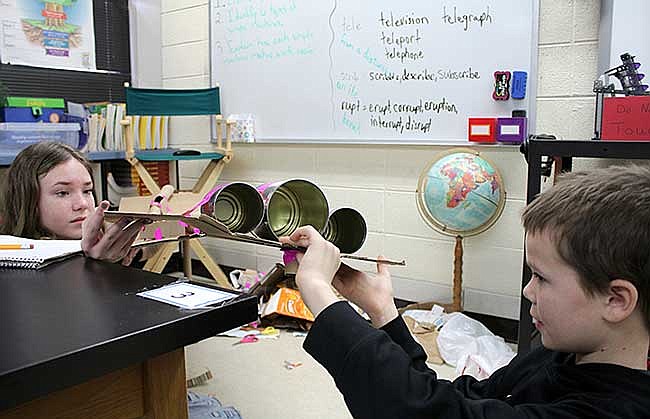MOKANE, Mo. - Under the careful hands of Manda Wilmsmeyer's fifth-grade students, contraptions of cardboard, plastic and tape were taking shape Friday at South Callaway Elementary School.
In one corner of the classroom, Kailey Brammann, Skyler Hoffman and Jasper Miller raised one side of a long cardboard panel covered in carefully taped tubes up into the air to form a ramp.
Also in the design specs? Tin cans and a flashlight.
"It's like an obstacle course for a marble to go through," Brammann said.
The idea is simple, Miller said. Once finished, the invention will help sleepy children wake up in the morning.
"The parents, they just come in and pull the string," he said. "Then the light shines in your face, and the marbles come down."
As they worked, the group discussed a potential name.
"How about 'Bright Noise'?" Miller asked. "Because we're going to have something bright, and we're going to have noise."
Hoffman gave the name some consideration, but Brammann had other ideas.
"'Distraction Matter,'" Brammann said firmly. "Because it looks like a distraction."
All throughout the classroom, other groups of students were hard at work cutting, taping and working together to bring similarly elaborate devices to life.
The students will put their projects on display Thursday for parents and fellow students at South Callaway Elementary's annual Invention Convention.
"I don't let them take it home," Wilmsmeyer said. "I don't want them to take it home and then the parents put some ideas into their head about it or their parents work on it - it's got to be all the kids' doing."
In the past, students have been tasked with designing a new toy or game, but this year, they're working to create a solution to a real-world problem.
"I always thought it would be fun to let fifth-graders just make their own toys," Wilmsmeyer said. "But with our standards - the way they have changed and grown and progressed over the years - they've pushed engineering to be more real-world problem-solving."
In the past, Wilmsmeyer said, the students mostly just designed toys they personally thought would be fun. Now, they're thinking about other people.
Across the room, Alexis Cheney, Davion Roberson and Ethan Munford discussed axles and wheels. Their invention, a box big enough for a child to sit in, is meant to serve as a sort of wheelchair.
Cheney and Munford point to Roberson as the idea-man of the group.
"I was thinking of like a nurse bed - it's something that they can lay in and also play in basically," Roberson said. "You see how it's created like a Go-Go car?"
Wilmsmeyer isn't surprised by the creativity or ambition exhibited by her students.
"That's a tough thing to figure out as a fifth-grader, you know, wheels and axles alone," Wilmsmeyer said.
Wilmsmeyer surveyed her classes to come up with project prompts.
"I took one of the ideas from the students, and that was something to wake you up in the morning," Wilmsmeyer said. "And I took an idea that we have issues with here in the classroom every now and then, and that's to pick up and transport a bug safely. The third idea, helping someone with the disability, was one that we found online."
Garrett Wright's group designed a plastic bug trap, controlled by what looked like a kite string.
"My friends, my teammates, they thought that it would be fun," Wright said. "There are a lot of people who are scared of bugs, scared of touching them. If you use a tissue, blood could go through it if you squish it."
Other groups also designed their own version of bug-catchers - Shelby Lindholm's decided to go with a bug-elevator.
Lindholm and her partners, Zane Boudreaux and Hudson Jones, are fairly certain their idea is unique - no one else seems to have built an elevator.
"For some reason, it just popped into my head," Lindholm said.
The projected is designed to give students the chance to try out ideas and build something on their own. Throughout the process, Wilmsmeyer teaches about simple machines and the engineering process.
"This is a project that the visitors get to actually touch and use what the kids have created," Wilmsmeyer said.

